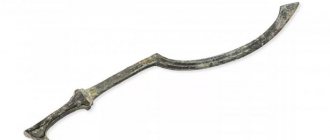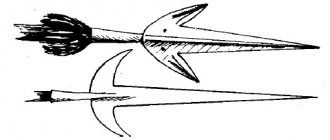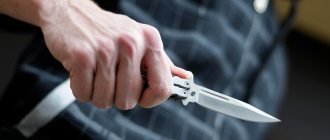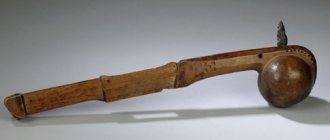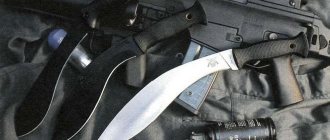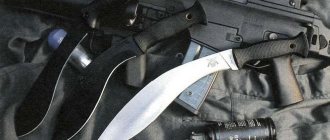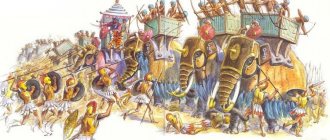We often judge historical events by the unique archaeological finds found. Thanks to ancient artifacts, we have an idea of how ancient states developed, how developed their culture, economy was, and what the political structure looked like. Not least on the list of artifacts are military items and weapons. Today, archaeologists and historians, based on the finds they have found, can judge what kind of weapons people possessed in ancient times, and what successes this or that civilization was able to achieve in the military field.
The richest collection of artifacts, which today is presented in many museums around the world, belongs to the era of Ancient Egypt. It was this state that was the most powerful and largest in ancient times. Thanks to its economic and socio-political structure, the Egyptian Kingdom dominated for two millennia. The Egyptians were not only skilled farmers and builders. Egypt owes much of its rise to military success.
The Egyptians managed to create one of the strongest armies of antiquity, in which elite units occupied a special place. The Pharaoh's army was equipped with various weapons, but the most famous was the khopesh, the sword of the Egyptian special forces. This edged weapon is considered the most famous that has survived to this day. In museums, this is the most common exhibit in the exposition of ancient Egypt. Dozens of films have been created about the legendary land of the pharaohs, where warriors fight with curved, sickle-shaped swords.
Description of the sword
During the New Kingdom, high-quality weapons were made mainly from copper and bronze.
This metal was more accessible in those days. The mines extracted copper and tin using the open-pit method acceptable at that time. In addition, processing of the alloy did not require complex technological processes. However, bronze was valued at that time, and metal products, including weapons, were available mainly to wealthy people. In the army, wealthy warriors in high ranks were armed with swords and daggers.
Archaeological excavations in the areas where the Nile River widened have discovered new burial places for the highest ranks of Ancient Egypt. Well-preserved weapons were found in the tombs, among which was the khopesh sword.
When examining the sword alloy in the laboratory, it was found that the structure of bronze contains ferrosilicon and ferrosilicomanganese ferrosilicon additives.
These components gave the metal additional strength. Thus, the conducted hydrocarbon studies make the discovery that metallurgy in Ancient Egypt was at a high level.
The sword was sharpened from the outer edge. Sometimes archaeologists came across swords sharpened on both edges.
The long handle of the sword made it possible to hold it freely with both hands. The total length of the sickle-shaped blade ranged from 50 to 70 cm, and such a sword weighed about two kilograms. However, specimens have been found reaching a length of more than one meter and weighing up to four kilograms. Most likely, a large specimen was used in ritual ceremonies.
The unsharpened inner side of the sword made it possible to carry it on the shoulder. This position can be found on ancient Egyptian frescoes. Small blades were worn on a belt near the hip. This type of weapon did not have a sheath.
Description of khopesh
Bronze was used for military weapons in ancient times. It was the only available metal that could be mined in an almost open-pit manner and did not require special technological efforts to smelt. Despite this, metal weapons were considered the prerogative of rich people. Only high military ranks could afford to have bronze knives and swords. Bronze is a fairly heavy metal, so the bronze khopesh is a heavy and at the same time durable weapon.
During excavations in the middle reaches of the Nile, ancient burials belonging to members of the Egyptian military nobility were found. Sickle-shaped swords in well-preserved condition were found in the tombs. A more detailed hydrocarbon analysis revealed impurities in the bronze composition. Elements such as ferroscilium and ferrosilicomanganese are commonly used in metallurgy to give the metal special strength and stability. Such research results indicate that in Ancient Egypt, weaponry was at a high technological level.
The sickle-shaped sword was sharpened only from the outside. Less commonly found were double-edged swords, sharpened not only on the outside, but also with a cutting edge on the inside. Obviously, the method of using such weapons in battle involved not only cutting blows, but also cutting off the head and limbs of a defeated enemy. The length of the blade's handle indicates that the khopesh was a two-handed sword. The length of the sword was on average 50-70 cm. Among the finds there are artifacts that have a long handle, and the blade itself reaches a length of about a meter.
The shape of the sword also suggests the way the weapon is carried. On many ancient frescoes you can find images of ancient Egyptian warriors carrying a curved sword on their shoulder. In some cases, when the blade was small, it was worn at the hip, on the belt. The weapon was kept without a scabbard. The weight of the sword was approximately 2 kg. There are artifacts with a large weight, reaching 3-4 kg. However, it is most likely a ritual weapon that was used in various ceremonies.
For reference: as a result of research conducted by employees of the London Historical Museum, it was possible to determine the effectiveness of the combat use of khopesh. The sword was used to strike the pork carcass from different positions. During the inspection and study of the damage, it was found that the competent use of a sickle-shaped sword in battle did not leave the enemy any chance. The wounds were deep and long. The edges of the wound had an almost perfectly straight line, which made subsequent tissue healing difficult.
Weapons and military organization of the New Kingdom
The technical innovations described above made it possible to significantly reconstruct the entire military organization of the state. In addition to the infantry inherited from previous centuries - "mesha", charioteers - "netheter" appeared, who became a kind of elite of the army. They devoted their entire lives to studying fighting skills and passed down seats in chariots from father to son.
The clothing and weapons of the infantrymen of Ancient Egypt also underwent changes. Heart-shaped printed protective aprons were added to the previous skirts to cover the warrior’s belly. Fur wigs that did not justify their worth and fell out of use were replaced by headscarves that protected them from the scorching rays of the sun.
The equipment of the Egyptian soldiers of the New Kingdom period was presented in its entirety at the Battle of Kadesh (1274 BC), where their army clashed on the battlefield with the troops of the Hittite kingdom. Ancient Egypt, whose weapons continued to improve, in addition to its traditional types, such as bows, spears, darts, battle axes, axes, daggers and the khopesh that appeared shortly before, which were described above, on that day showed the world two completely new types of daggers .
Their double-edged blades, forged from steel (previously they were made from bronze), had a leaf-shaped shape in which they gradually sharpened at the ends. The handles, equipped with cone-shaped bells, were also comfortable. They were identical in design, the difference being mainly in size. This battle became a kind of boundary at which bronze and copper in the hands of warriors gave way to steel.
In subsequent historical periods, the weapons of Ancient Egypt (photos of individual samples are presented in the article) underwent further changes, which were the result of both technical progress within the country itself and the development of international relations.
An expensive, weighty, universal blade that combines the shape and functions of a sword, sickle and ax. This was the khopesh, which brought many victories to the Egyptians during the New Kingdom. It was worn exclusively by military leaders and experienced warriors. And unsharpened specimens were an indispensable attribute of various rituals. Many clues related to khopesh were found in the Egyptian pyramids - these include thematic images and well-preserved examples of weapons.
Khopesh is one of the most popular weapons of Ancient Egypt. Such designs were widely used by the most developed civilizations from ancient times until the 6th century. The unusual sickle shape made this sword a universal weapon: it could cut, chop and stab. A great advantage of the khopesh was that the wounds inflicted by it were much deeper than cuts made with a battle axe. Thanks to such great efficiency, this blade has become a kind of symbol of Egypt.
Egyptian infantry
During the Old Kingdom (2650-2150 BC), the army of Egypt was a popular militia. The number of adult men who could be called up for military service reached tens of thousands. In the south, if necessary, mercenaries could be recruited from the Nubian tribes. The regular army was mainly busy guarding the borders, and this was enough to protect Egypt from the main threat - raids by Libyan and Nubian tribes. Only occasionally were punitive expeditions undertaken into Nubia or against Asian tribes - to the Sinai Peninsula or to Southern Palestine.
The decline of the Old Kingdom occurred around 2150 BC, a transition period accompanied by natural disasters and civil wars. The army of the next period, the so-called Middle Kingdom (2050 - 1640 BC), was formed on the basis of conscription: one adult man out of every hundred people became a soldier. The army was commanded by senior officers chosen personally by the pharaoh. One of them had the title of "commander of shock troops", which implies the existence of heavy infantry for shock operations.
Around 1700 BC Egypt was invaded by the Hyksos, an Asian people composed of Semitic and Hurrian tribes, who used political divisions within Egypt and their military superiority to subjugate Egypt. The Hyksos changed Egyptian military culture by introducing new technologies that spread throughout the Middle East. They taught the Egyptians to make fairly fast and strong chariots. They brought with them high quality bronze weapons, as well as a more powerful compound bow.
Before this, the Egyptians used simple bows made of wood or reeds that could shoot no more than 100 m (330 ft). The compound bow was of Asian origin, it consisted of a wooden base, reinforced on the inside with strips of horn glued to it, and on the outside with tendons; Before pulling the string, the bow was bent in the opposite direction, due to which the bow acquired greater strength, it could hit a target at a distance of up to 200 m (650 ft).
Arrows with bronze tips had greater penetrating power. Later models of the compound bow were able to penetrate metal armor at distances of up to 200 m (650 ft), and their range almost tripled compared to a simple bow. Armed with compound bows, the armies of the Ancient Near East increasingly relied on archer units, while heavy infantry shock units also remained important.
The Egyptian army of the New Kingdom era (1565-1085 BC) combined Egyptian administrative organization, Hyksos military technology and new tactics, which were basically offensive. The core of the army was made up of professional soldiers, attracted by the opportunity to gain booty, slaves and land holdings, who later formed a separate military class as their sons continued the work of their fathers.
During critical periods, the army was replenished by conscription, initially 1 man for every 100 adult males (as in the Middle Kingdom), and with the invasion of the Sea Peoples in 1200 BC. the number of recruits increased to 1 man from every 10 men. Since Egypt was no longer a tribal society, but an urban civilization, not every man was a warrior. The soldiers underwent special training before they were allowed to go into battle. A drawing has survived that depicts archers training under the supervision, apparently, of military instructors.
Unfortunately, the surviving accounts of the battles of Megiddo (1482 BC) and Kadesh (1300 BC) contain mainly praise for Thutmose III and Ramesses II rather than descriptions of the battles themselves. However, there is a wealth of pictorial and documentary evidence of how the Egyptian army of the New Kingdom operated. The regular Egyptian infantry was divided into companies of 250 men, which in turn were divided into platoons of 50 men, and consisted of two types: archers, who by the time of the Battle of Kadesh were all armed with a compound bow, and nakhtu-aa (shock troops, or heavy infantry). During this period, archers typically wore only loincloths or some sort of kilt.
A relief from the time of Queen Hatshepsut (1503–1482 BC) depicts soldiers armed with broad-headed spears, short hatchets with a small bronze blade, and small wooden shields with a semicircular top. From 1500 BC warriors began to wear armor - initially it was a rough cloth wrapped around the body, as well as leather or bronze helmets. Some units were armed with short spears, like the iklwa among the Zulus.
By the time of the Battle of Kadesh, the Nakhtu-a'a generally had armor and shields that had a rounded top as before, but increased in size, allowing the warriors to form a shield wall, like a phalanx. The bronze hand hatchet gave way to the khepesh, a one-handed bronze knife with a curved blade without a point - not quite a sword, but not an ax either - while some used two-handed mace-axes, which had a heavy round butt and a semicircular blade.
Infantry tactics were based on the fact that at the beginning of the battle, archers delivered a massive blow to the enemy, which could be decisive, given the strength and accuracy of the compound bow, the degree of training of Egyptian archers and the rarity of reliable armor at that time. Apparently. The archers were positioned in lines and trained to fire volleys, supporting the advance of the nakhtu-aa chariots, from which the warriors threw spears before taking up the he-pesh. or an ax, and engage hand-to-hand with the enemy’s front line, already weakened by a hail of arrows from Egyptian archers.
The Egyptian infantry also included mercenaries. The Medjay, Nubian nomads who acted as skirmishers in the early New Kingdom, used simple wooden bows with crossbars. They were highly respected and later guarded the tombs of the pharaohs in the Valley of the Kings. Starting around 1200 BC. The Middle East was subject to several waves of invasion by the Sea Peoples, Indo-European tribes, people from Asia Minor and the Aegean Sea regions. The most famous of them are the Philistines, who settled in the lands of Canaan along the Palestinian coast.
The Sea Peoples began to penetrate Egyptian society several generations before the main invasion as traders, settlers and mercenaries: for example, the bodyguards of Ramesses II at the Battle of Kadesh were from the Sherdenope tribe. The Sherdens were the first swordsmen in history; the metal sword was a native Indo-European weapon. Images from that time show the Sherden and Philistines dressed in bronze armor and helmets: with horns for the Sherden, with a feather crest for the Philistines. Both are depicted with round shields about 1 m (3 ft) wide, with a single strap for the hand, which made them more convenient than Egyptian shields. Their main weapon was a cutting sword, about 1 m (3 ft) long, tapering to a point, the handle and blade of which were apparently cast together like the bronze knives on display in the British Museum.
Swords were probably originally made of bronze, but... Beginning around 1200 BC, they began to be forged from iron, a new metal that made it possible to obtain a good cutting surface. The story of the Philistine Goliath of Ai suggests that the duels between individual heroes that preceded the battle played an important role in the military affairs of the Sea Peoples.
Kakute
A fighting ring or kakute is a non-lethal type of Japanese weapon, which consists of a small hoop encircling the finger and riveted/welded spikes (usually from one to three). A warrior usually wore one or two rings - one on the middle or index finger and the other on the thumb. Most often, rings were worn with the spikes inward and were used in cases where it was necessary to capture and hold a person, but not kill him or cause deep damage. However, if the kakute were turned with their spikes outward, they turned into serrated brass knuckles. The goal of the kakute was to subdue the enemy, not to kill him. These fighting rings were especially popular among kunoichi - female ninjas. They used poison-coated kakute for quick, fatal attacks.
Infantry shields and wigs
The Egyptians' battle shields were mainly of two types - large, reaching almost to the warrior's chin and pointed at the top, and smaller ones, which had a rounded shape. Both of them were equipped with special belts on the inside that made it possible to hold them and easily perform various combat techniques.
As for the clothing of the ancient warriors, due to the dry and hot climate they did not have any special uniform. Their usual attire consisted of a short skirt, also common among the civilian population, as well as sheepskin wigs. This seemingly decorative attribute nevertheless had a purely utilitarian purpose. Made from several layers of sheepskin, with the fur turned outward, such headdresses played the role of helmets that protected the warrior’s head from the blow of a club or mace.
Description of the weapon and features of its combat use
The length of the khopesh could be different. As a rule, its dimensions did not exceed 50-60 cm, but in some examples of this weapon the length of only one handle was 70 cm. In this case, the khopesh turned into a kind of small halberd. The shape of the khopesh blade differs in the degree of its curvature, as well as the distance from the handle to the point where the blade begins to bend. Some of the swords found have a small hook at the end of the blade, which was probably used to grab the enemy.
The handle of the khopesh could be either one-handed or two-handed.
As mentioned above, khopesh were made of bronze, so the weight of this weapon was very decent - about two kilograms. Usually the blade was sharpened on the outside, but there were also double-edged weapons. There was another interesting way of sharpening weapons: the part of the blade located closer to the handle was sharpened from the outside, and the far part from the inside. Archaeologists have discovered completely unsharpened khopesh. It is obvious that they were used for ritual purposes.
Due to the significant cost of the metal in that era, it was likely only the very wealthy could afford it. It is possible that some ancient Egyptian elite units, such as the personal guard of the pharaoh or the court guard, were armed with khopesh. This is not known for certain.
The Khopesh was a very lethal weapon. Thanks to its shape, it could inflict very serious cut and chop wounds. Moreover, he did the latter even better than with an axe. The curved shape of the blade made it possible to strike with “pull”, like later sabers.
In addition, during a battle, a warrior could use the curved butt of a khopesh to capture the enemy himself or, for example, his shield.
In general, it should be noted that the classification of khopesh also raises many questions. Despite the curvature of the blade, most researchers (probably out of habit) classify khopesh as swords and not sabers, which, to put it mildly, is not controversial. However, the khopesh with its semicircular blade is definitely not a sword; rather, it is closer to battle axes.
These Egyptian swords were not only used in war, they were also used for executions. Scientists were told about this by numerous bas-reliefs on which prisoners were executed with the help of these weapons.
The images also told us how ancient warriors typically wore khopesh. As a rule, it was simply placed on the shoulder, butt down. It was very difficult to make a sheath for a weapon of such a complex shape. Sometimes it was simply fastened to the belt.
In recent decades, the popularity of the ancient Egyptian sword khopesh has reached unprecedented heights. For this, first of all, we need to say thanks to the cinema. This weapon is constantly present in films with an “Egyptian” theme; the khopesh is also extremely popular in computer games. Even in the already cult series “Game of Thrones” based on a series of novels by Martin, the wild nomadic Dothraki use a sword called “arakh”, which in its shape is very reminiscent of the Egyptian khopesh.
The khopesh sword is a weapon of the New Kingdom in Ancient Egypt, which existed from 1600 BC. e. The sickle-shaped blade has a strange name, which means the front leg of an animal. In battle, the khopesh inflicted terrible injuries on the enemy in the form of deep, cut and chopped wounds. This blade combined the functions of a scimitar sword.
The unusually shaped blade was used by shock troops in the Egyptian army. Among the mass of artifacts of ancient Egypt, the khopesh weapon is most famous to modern historians. Most museum halls of ancient Egyptian art have an exhibit of this unusual sword.
Artifacts
According to historians, the khopesh is the first weapon on earth that can be classified as a sword. This is also confirmed by archaeologists, because earlier varieties could not be found. At least for now.
As mentioned above, evidence of the use of khopesh by the ancient Egyptians comes from wall paintings found inside the pyramids. The images show the kings of Egypt holding exactly such swords in their hands. And during excavations carried out in the tomb of Tutankhamun, archaeologists also found samples of these weapons.
Ancient Egypt is without a doubt one of the greatest civilizations in human history. The highest level of development of agriculture, crafts, science and construction provided the Kingdom of Egypt with almost two thousand years of hegemony in the Mediterranean region and the Middle East. At its height, the Egyptian state controlled not only the Nile Valley, but also vast territories in North Africa, Palestine and Syria.
But empires are not created by builders, mathematicians or peasants; their emergence requires a powerful military machine, which, without a doubt, Egypt had. The most recognizable symbols of Egyptian military power are the war chariots and, of course, the sickle-shaped khopesh sword, which was especially common during the New Kingdom, the time of greatest power of Egypt.
The name of the sword translates as “animal leg,” and historians debate which limb (or part of it) the ancient Egyptians had in mind. Some scholars argue that the name should be translated as “thigh”, others – “front leg”, and still others believe that “khopesh” generally means “knee”. The shape of this weapon actually resembled a cattle limb. However, for our further story, the exact translation of the name of the sword is not too important.
It is unlikely that the entire Egyptian army was armed with khopesh. These swords were made of bronze, a rare and very expensive material at that time. Historians believe that the khopesh was the weapon of the military elite of the Egyptian army. It is likely that this sword had great symbolic meaning and was a very status item. Various pharaohs are very often depicted with khopesh. They are often found in the tombs of nobles and kings; for example, two such swords were discovered in the famous tomb of Tutankhamun.
Organization of the Egyptian army during the Middle Kingdom
The TERRITORY of Egypt during the Middle Kingdom was approximately 35 thousand square meters. km. Its population, according to ancient authors and modern estimates, was approximately 7 million people. Judging by the available data on recruitment in one of the nomes (one warrior per hundred men), the Egyptian army could consist of several tens of thousands of warriors. Several thousand warriors usually went on a campaign. The pharaoh had with him “retinue people” who made up his personal guard, and “companions of the ruler” - a group of noble warriors loyal to him, from which military leaders were appointed: “chief of the army”, “chief of recruits”, “military commander of Middle Egypt” and others superiors.
The armament of Egyptian warriors during the Middle Kingdom period improved somewhat compared to the previous period, as metal processing became more advanced. Spears and arrows now had bronze tips. Impact weapons remained the same: a battle axe, a spear up to 2 m long, a mace and a dagger.
A spear for throwing, a boomerang, a sling for throwing stones, and a bow were used as throwing weapons. A reinforced bow appeared, which increased the range of the arrow and its accuracy.
The arrows had tips of various shapes and feathers; their length ranged from 55 to 100 cm. Common arrows in the ancient East with a leaf-shaped tip, initially flint, and then copper and bronze, were less effective weapons than the arrows with a faceted tip - bone or bronze, introduced by the Scythians in the second quarter of the 1st millennium. The fur-lined shield, half the height of a man, continued to be the only protective equipment.
During the Middle Kingdom, the organization of the army was improved. The units now had a certain number of 6, 40, 60, 100, 400, 600 soldiers. The detachments numbered 2, 3, 10 thousand soldiers. Units of uniformly armed warriors appeared - spearmen and archers, who had a formation order for movement; They moved in a column of four rows along the front and ten ranks deep.
For their merits, warriors were promoted, received land, livestock, slaves, or were awarded “gold of praise” (like an order) and decorated military weapons.
From the west and east, access to Egypt was reliably protected by the Libyan and Arabian deserts.
To protect the southern border, three lines of fortresses were built in the area of the first and second cataracts of the Nile. The fortresses became more advanced: they now had battlements that covered the defending soldiers; protruding towers for shelling the approaches to the wall; a ditch that made it difficult to approach the wall. The fortress gates were protected by towers. Small exits were arranged for forays
Much attention was paid to supplying the fortress garrison with water; wells or hidden exits to the river were built
Of the surviving remains of ancient Egyptian fortresses from that period, the most characteristic is the fortress at Mirgissa, built in the shape of a rectangle.
This fortress has an internal wall 10 m high with protruding towers located at a distance of 30 m from one another on the face opposite the river, and a ditch 8 m wide. An external wall was built 25 m from the internal wall, which surrounds the fortress on three sides; on the fourth side the cliff drops steeply towards the river. The outer wall is surrounded by a ditch 36 m wide. In addition, forward walls were built on rocky ledges, adjacent to the corners of the fortress and allowing flanking the approaches from the river. Other walls protected the main entrance to the fortress. The fortress in Mirgissa was already a complex defensive structure, which was based on the requirement of flanking the approaches. This was a step forward in the development of fortification - one of the branches of military art.
The most vulnerable place in the country's defense was the north - the lower reaches where the Nile flows into the Mediterranean Sea were open to conquerors. When the power of the pharaohs in the country was strong, it was here that the Egyptians kept the bulk of their fleet and land army. But during the uprisings against the tsarist government, the defense of the northern borders was sharply weakened, and Asian nomads could freely penetrate into Egypt.
The pharaohs and their commanders tried to fight quickly in order to return their troops home within a few months. Often the Egyptian army returned home after a three- or four-month campaign, having captured only one or two small fortresses. Major battles rarely happened - the commanders took care of the soldiers, whom they called “the flock of God.”
The history of the appearance of khopesh weapons
The Egyptian soldier, skillfully wielding a spear and sword, represented a formidable enemy on the battlefield in ancient times. Infantrymen, armed with sharp curved swords, inflicted a stunning blow on the enemy in close combat, which is why the khopesh is considered to be the main infantry weapon in Ancient Egypt.
The legendary weapon came to Egypt somewhere in the middle of the 2nd millennium BC, during the era of the Middle Kingdom. The Egyptians faced formidable swords during the battle with the Hyksos, who invaded the land of the pharaohs from what is now Palestine. These nomadic tribes, unlike the Egyptians, were armed with curved and sharp swords. While the Egyptian infantry fought with maces and bronze axes, the nomads in close combat delivered devastating blows with their curved knives. After the defeat, the Egyptians adopted the battle tactics of their victors. The main weapons on the battlefield were chariots and warriors armed with sickle-shaped swords. After the curved and sharp sword became the main weapon of the Egyptian army, the pharaohs not only reconquered their territories, but also managed to conquer neighboring countries.
Curved, sickle-shaped swords in the old days were perhaps the main weapon of ancient armies. This is largely explained by the social composition of the combat units, where the majority of the army were peasants. However, according to historians and Egyptologists, metal weapons were a luxury item. Not every ordinary warrior could have a bronze sword. Most likely, such swords belonged to elite military units, the palace guard or the pharaoh's bodyguard. The origin of the blade's shape has other versions. A more plausible version is considered to be the transformation of a battle ax into a type of weapon capable of delivering secant blows, and not just chopping and punctuated blows. One cannot discount the theory in which the ancestor of the khopesh is considered to be the sappara, the weapon of the ancient Assyrians. Unlike the Egyptian sword, the Assyrian sappara has a sharp edge on the inside of the curve, which speaks in favor of an agricultural function.
According to the latest version, the khopesh had a sickle shape, taken from a peasant's sickle. Such swords are quite often found during excavations of ancient settlements of other civilizations. Probably, not only does this weapon belong to the civilization of agricultural states, but also the high fighting qualities that swords of this shape possessed. Swords of this shape are equally convenient for chopping and cutting. Compared to the battle ax and regular straight swords, the sickle blade causes deeper wounds and cuts.
The name of the sword, which became a symbol of Ancient Egypt, translated from Egyptian literally means “animal’s leg.” Later, in other armies of ancient states, similar weapons can be found in the arsenal of warriors. The swords and daggers in the army of Alexander the Great had a curved shape and were called kopis. Curved and curved swords were also the favorite weapons in the Persian army of King Xerxes.
History of origin
The main combat skill of the Egyptian warrior was mastery of weapons: sword, spear, battle ax. A soldier skillfully wielding weapons was a dangerous adversary. Before the New Kingdom, the army was weakly armed with spears and wooden shields. A little later, bronze axes appeared.
Starting from the reign of the 18th dynasty, reforms were carried out in the troops. Warriors began to actively use horses and war chariots. A kind of chopping and cutting weapon appeared.
Advance detachments, armed with an unusually shaped ax sword, inflicted deep cutting injuries on the enemy, practically incurable, given the level of development of medicine at that time.
The shape of the khopesh sword was partially borrowed from the Hykos, who invaded Egypt and conquered part of its lands during the reign of the XIII-XVII dynasties. The Hykos armies fought with curved swords, which were countered by the battle axes of the Egyptians.
The defeats of the army, as well as significant losses in close combat, forced Egyptian commanders to think about more effective weapons. The Egyptian army began to transform. In addition to war chariots, sickle-shaped swords appeared. Such a decisive step in updating the ammunition brought positive results.
The modernized Egyptian army not only recaptured previously lost territory, but also conquered new lands.
The Egyptian sword khopesh became one of the symbols of the military successes of the New Kingdom. It is worth adding that most of the Egyptian regiments were formed from peasants who did not possess combat skills.
In addition, khopesh was made of bronze, and this metal was brought to Egypt and they tried to use it sparingly. Mostly, sickle-shaped swords were used by the elite assault troops, the palace security service and the pharaoh's personal security service.
Combining the two types of weapons increased the characteristics of the new sword. Historians are inclined to this opinion. However, there is a version about the origin of khopesh from the sickle-shaped Assyrian blade - sappar.
It had an internal sharpening and could be used as an agricultural tool. But the first path of evolution of the ax sword looks more plausible.
The shape of the blade will remain unchanged for many centuries and will serve as a prototype for the creation of weapons in the armies of some ancient states. For example, a small part of the soldiers of Alexander the Great had swords - kopis, with slightly curved blades and similar to the ancient Egyptian sword of the New Kingdom of Egypt.
During the reign of Xerxes from 486 BC. uh, his Persian army was equipped with curved blades.
Features of the army of the Middle Kingdom period
The weapons of Ancient Egypt during the Middle Kingdom were supplemented by the widespread use of axes. In the previous historical period, they were already known on the banks of the Nile, but were used extremely rarely due to their high cost. This cutting-and-piercing weapon, which was like a wide curved ax mounted on a long shaft, was made of bronze, and therefore was extremely expensive.
As before, the army was divided into warriors who used shields in battle and those who did without them. The first included spearmen, who at the end of the Middle Kingdom were also joined by infantrymen with axes, and the second included warriors armed with darts, axes, axes, clubs and clubs.
Decline and subsequent revival of Egypt
For the Egyptians, the era of the Middle Kingdom ended very poorly. This happened partly due to the fact that they did not promptly strengthen the army with a new branch of the army at that time - war chariots, which their neighbors had long used. As a result, they received a bitter lesson taught to them by the nomadic Hyksos tribes.
Using high-speed two-seater chariots in battle, they made lightning-fast attacks, showering the enemy with a shower of arrows and safely escaping pursuit. For their mobile detachments, the army and weapons of Ancient Egypt, which had lingered at the previous stage of its development, did not pose a serious threat. The result was its capture by the Hyksos and the subsequent period of decline.
The revival of a previously powerful state, but defeated by barbarians, began around the 17th century BC. e. The main reason for this process was that the warriors of Ancient Egypt and their weapons underwent dramatic changes, allowing them to finally drive out the invaders.
First of all, they learned not only to breed horses, but also to manage them. In addition, Egyptian craftsmen adopted the technology of making war chariots from foreigners, and former infantrymen mastered the technique of conducting effective combat operations with their help.
Innovations in weaponry
At the same time, the most important factor that made it possible to raise the army's armament to a completely different level was the improvements achieved in metal processing. Thanks to them, the former flint tips of spears and arrows were replaced by iron leaf-shaped ones. The design of the bows themselves was also improved, making it possible to significantly increase their accuracy and combat range.
During this period, the previous types of weapons of Ancient Egypt, the names of which are mostly familiar to history buffs, were replenished with a new weapon, borrowed, according to researchers, from the Sumerians. It was the so-called khopesh - a type of edged weapon, consisting of a sickle-shaped curved blade and handle. A characteristic feature of this type of sword was its high penetration ability, which made it possible to defeat warriors dressed in metal armor.
It is very noteworthy that among the new types of weapons that appeared during this period there are also boomerangs, and in appearance they are practically indistinguishable from those used by the inhabitants of Australia and Polynesia. Since in this case any borrowing is excluded, it remains to be assumed that their homeland is directly Ancient Egypt.
Combat use of khopesh
Khopesh has not received widespread use. The main reason is the lack of expensive metal in such quantities to arm thousands of warriors. The main fighting force of ancient armies was infantry, recruited from the poorest segments of the population. Infantrymen were usually armed with bows, slings, spears and battle axes. Only elite units and cavalry were equipped with bronze swords, axes and daggers.
Wielding a sword required special skills and abilities, so sickle-shaped swords were used only by trained troops. The shape of the sword and its size made it possible to use it both on foot and on war chariots and in cavalry units. A massive and heavy khopesh, as a rule, was used to deliver a sliding-slashing blow to the head and neck. With sufficient force, a curved blade could pierce a helmet and cut a wooden sword. The palace guards and chariot leaders had large weapons capable of delivering crushing blows to the enemy.
In addition to combat use, the khopesh was one of the most common execution weapons in Ancient Egypt. On the frescoes and reliefs in the tomb of Pharaoh Ramses III there are scenes depicting execution. Captives or criminals were cut off with a sickle-shaped sword. It should be said that in ancient times, many peoples’ favorite method of collecting evidence in the final victory over the enemy was to cut off the heads of defeated opponents and captives. The Khopesh, with its curved sickle shape, can be considered an ideal weapon for these purposes.
Khopesh was used in military service and for ritual purposes until the 4th century BC. At a later time, similar weapons can be seen in the arsenal of other armies. Despite their effectiveness in battle, Egyptian swords are fashionably considered regional ethnic weapons. Curved swords did not become widespread in the ancient world. The inconvenience of the shape of the blade and the special specificity of using such weapons in battle had an effect.
Innovations in combat tactics
The order of formation of combat phalanxes has also partially changed. If in the previous period they were single-row, now the soldiers began to line up in several ranks, standing one after another. At the same time, those who were placed in the back rows had spears with longer shafts, which allowed them to also hit the enemy.
This arrangement of spearmen was called deep formation and was then used by many armies. Despite the fact that the most perfect example of this is the famous Macedonian phalanx, this innovation was tested and developed by Ancient Egypt, whose weapons even at that time made it possible to use similar battle tactics.
A characteristic feature of the Egyptian army of the Middle Kingdom is that it consisted exclusively of infantry and did not yet use horses, although they were already known on the banks of the Nile in that era. As before, during the fighting, an important role was assigned to archers, whose weapons had several modifications.
It was a very formidable force. Calculations show that warriors armed with the simplest bows, made from one piece of wood and reaching one and a half meters in span, were capable of hitting the enemy at a distance of up to 150 meters. At the same time, there were more advanced examples of these weapons, assembled from various types of wood and covered with leather. But because of their high cost, they were hardly available to ordinary soldiers.
The influence of the Egyptian khopesh sword on other cultures
Beginning around the 6th century BC, the Greeks began using a curved blade they called mahaira or kopis. Some scholars suggest that the name kopis may have been derived from the Egyptian word khopesh. Additionally, the Hittites, the sworn enemies of the Egyptians, also used swords similar in shape to the khopesh during the Bronze Age. However, it is unclear whether they copied the Egyptian design or inherited the khopesh directly from Mesopotamia.
Limestone ostracon showing Ramesses IV of the 20th Dynasty slaying his enemies, circa 1156-1150 BC.
Curved swords similar to khopesh are also found in eastern and central Africa. Cultures in the region that includes modern-day Rwanda and Burundi used sickle-shaped daggers comparable to the khopesh. It is unclear whether these blade-making traditions were inherited from Egypt or whether the dagger design was developed independently south of Mesopotamia.
